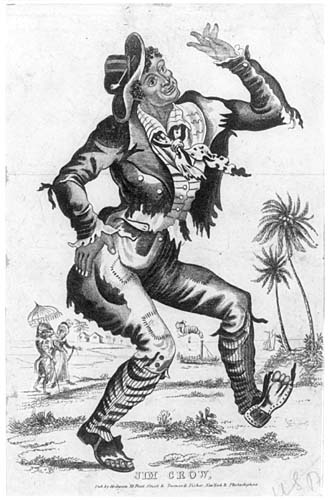Title
Railroad Overture
Type
Song
Description
[Alternately: “The Railroad Overture or Locumloshus Jimjam”]
To listen to this song (and others) on the Artists Respond to Juba Site, Click Here and/or Here.
This instrumental was meant to imitate the sounds of a locomotive. As the prefatory note for the Leoni Lee and Coxhead edition states: “The Rail-Road Overture or Locumloshus Jimjam; which at de fust ob de begginnin commence wery moderate; but when it gits into de circumlution ob de centre ob grabity, it goes into a kind ob canstopimization an run clear off de track!” Mahar suggests a thematic similarity between this song and the “Locomotive Lecture” which came to be a standard component of the minstrel show in the mid-nineteenth century. The Lecture was a recitation of an invented narrative accompanied by sound effects produced by bone castanets (17-18). Unlike the “Locomotive Lecture,” however, “The Railroad Overture” relied exclusively upon the instrumental ensemble placing particular emphasis upon the bones and/or tambourine player(s).
While the piece appears to have been quite popular during the period in question – often functioning as either the opening or closing number – its popularity most certainly did not endure into the twentieth century. With neither evidence to support any transmissions of the song, nor any recorded versions of the song (excepting the version recorded for The Mid-Atlantic Minstrel Show), it seems likely that the novelty of the song worked against its continued popularity. It is recommended to the reader that s/he listen to the recorded version provided here. Structurally, it is consistent with other songs in this canon with respect to the presentation and development of melodic material. Accordingly, it seems likely that the song’s attraction was as a vehicle (so to speak) for the troupe’s efforts to imitate the sounds of a locomotive, rather than with the music. Minstrel performers were, in the performance of some numbers, frenetic in their movements and physically all-encompassing in their noise-making – using feet, hands, body as percussive instruments as much as their violins and banjos in a show that appeared to be out of control.
Works Cited:Keller, Albert, arranged by. “The Railroad Overture or Locumloshus Jimjam.” London: Leoni Lee & Coxhead: n.d.
Mahar, William J. Behind the Burnt Cork Mask: Early Blackface Minstrelsy and Antebellum American Popular Culture. Chicago: Illinois UP, 1999.
To listen to this song (and others) on the Artists Respond to Juba Site, Click Here and/or Here.
This instrumental was meant to imitate the sounds of a locomotive. As the prefatory note for the Leoni Lee and Coxhead edition states: “The Rail-Road Overture or Locumloshus Jimjam; which at de fust ob de begginnin commence wery moderate; but when it gits into de circumlution ob de centre ob grabity, it goes into a kind ob canstopimization an run clear off de track!” Mahar suggests a thematic similarity between this song and the “Locomotive Lecture” which came to be a standard component of the minstrel show in the mid-nineteenth century. The Lecture was a recitation of an invented narrative accompanied by sound effects produced by bone castanets (17-18). Unlike the “Locomotive Lecture,” however, “The Railroad Overture” relied exclusively upon the instrumental ensemble placing particular emphasis upon the bones and/or tambourine player(s).
While the piece appears to have been quite popular during the period in question – often functioning as either the opening or closing number – its popularity most certainly did not endure into the twentieth century. With neither evidence to support any transmissions of the song, nor any recorded versions of the song (excepting the version recorded for The Mid-Atlantic Minstrel Show), it seems likely that the novelty of the song worked against its continued popularity. It is recommended to the reader that s/he listen to the recorded version provided here. Structurally, it is consistent with other songs in this canon with respect to the presentation and development of melodic material. Accordingly, it seems likely that the song’s attraction was as a vehicle (so to speak) for the troupe’s efforts to imitate the sounds of a locomotive, rather than with the music. Minstrel performers were, in the performance of some numbers, frenetic in their movements and physically all-encompassing in their noise-making – using feet, hands, body as percussive instruments as much as their violins and banjos in a show that appeared to be out of control.
Works Cited:
Mark Turner

